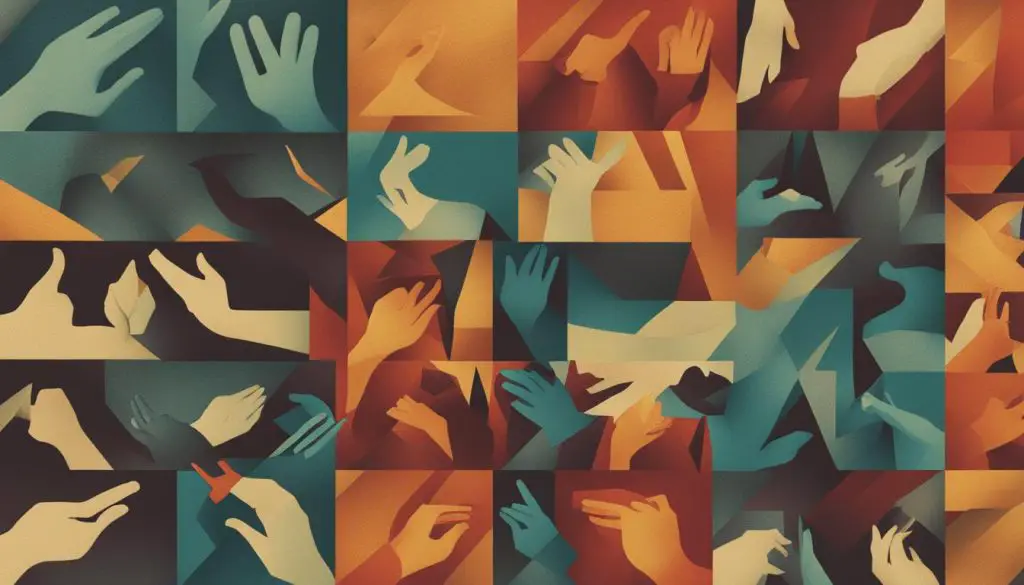American Sign Language (ASL) is the sign language used by Deaf people in the United States and Canada. This article will provide a simple guide on how to say good luck in ASL. It is important to note that ASL is a visually-gestural language, where hand shapes, movement, and facial expressions are used to convey meaning.
Contents
Key Takeaways:
- Saying good luck in American Sign Language (ASL) involves using specific signs for “good” and “luck.”
- ASL is a unique form of communication that relies on visual-gestural elements.
- Learning ASL requires interaction and exposure to the Deaf community.
- Understanding the cultural nuances of ASL is crucial when communicating with Deaf individuals.
- ASL has a rich history dating back to the early 1800s and has been shaped by the Deaf community in the United States and Canada.
American Sign Language 101: Learning the Basics
Learning American Sign Language (ASL) is an exciting journey that opens doors to communication with the Deaf community. Before diving into specific signs, it’s important to understand the basics of ASL and how it differs from other sign languages around the world.
ASL is a complete language with its own grammatical structure and vocabulary. It is not a universal language, and each country has its own sign language. ASL is primarily learned through vocabulary and sentences that are tied to real-life situations. To become fluent in ASL, interaction and exposure to the Deaf community are essential as fluency takes time and practice.
When learning ASL, it’s crucial to remember that this visual language relies not only on hand shapes and movement but also on facial expressions and body language to convey meaning effectively. Understanding and using proper facial expressions and body language can greatly enhance your ability to communicate in ASL.
Building a Strong Foundation in ASL
- Start by learning common phrases and vocabulary related to everyday activities.
- Practice finger-spelling, which involves using specific hand shapes to represent letters of the alphabet.
- Watch ASL videos or interact with the Deaf community to improve your receptive skills and learn proper signing techniques.
- Attend ASL classes or workshops to receive formal instruction and guidance.
By focusing on these foundational aspects of ASL, you’ll be well on your way to effectively communicate in sign language and develop a deeper understanding of the Deaf community and its culture.
Basic Vocabulary in ASL
In American Sign Language (ASL), there are specific signs for different words and phrases, including how to say good luck. Here are some basic vocabulary signs that you can learn in ASL:
Greetings
- Hello: To sign hello in ASL, you raise your dominant hand in a loose fist and bring it up to your forehead, then move it forward and away from your body.
- Goodbye: The sign for goodbye in ASL is done by extending your arm in front of you and waving your hand side to side.
Expressing Gratitude
- Thank you: To sign thank you in ASL, you place your hand against your chin and move it forward. This sign can also be accompanied by a slight nod of the head.
Apologizing
- Sorry: The sign for sorry in ASL is made by extending your dominant hand and touching it to your chest with an open palm, then moving it in a circular motion.
Saying “Good Luck”
To say “good luck” in ASL, you can use the sign for “good” followed by the sign for “luck.” The sign for “good” is made by forming a flat hand and brushing it against the palm of your other hand. The sign for “luck” is made by forming a loose fist and tapping it against your other hand. Combine these signs together to convey the phrase “good luck” in ASL.
Remember, ASL is a visual language, so facial expressions and body language also play a role in conveying meaning. Practice these basic signs and continue to expand your ASL vocabulary to better communicate with the Deaf community.

Cultural Considerations in ASL
When learning American Sign Language (ASL), it is important to not only focus on the technical aspects of the language but also to understand and respect the cultural nuances that are intertwined with it. ASL is not just a language; it is a vibrant part of Deaf culture, and by immersing yourself in the culture, you can enhance your communication skills and deepen your appreciation for ASL.
One key aspect of ASL culture is the use of facial expressions and body language to convey meaning. In ASL, these non-manual markers are just as important as the signs themselves. Facial expressions can indicate emotions, intensity, and even grammatical information. Body language, such as shifting body position or leaning in, can also convey meaning in ASL conversations.
Additionally, ASL has its own unique set of social norms and customs. For example, in Deaf culture, it is considered impolite to interrupt a conversation or to visually block someone’s view of a signing conversation. Instead, individuals often wait for a natural pause or politely tap the shoulder to gain attention. By understanding and adhering to these cultural norms, you can ensure respectful and effective communication in ASL.
| Cultural Considerations | Benefits |
|---|---|
| Immersing yourself in the Deaf community | Enhancing your ASL skills and fluency |
| Respecting facial expressions and body language | Conveying meaning accurately in ASL conversations |
| Understanding social norms and customs | Promoting effective and respectful communication |
By embracing the cultural aspects of ASL, you can truly connect with the Deaf community and gain a deeper understanding of their experiences and perspectives. This not only enriches your journey in learning ASL but also promotes inclusivity and appreciation for the diversity of human communication.

Table: Key Milestones in the History of ASL
| Year | Event |
|---|---|
| 1817 | Thomas Hopkins Gallaudet establishes the first American school for the Deaf. |
| 1819 | Laurent Clerc, a Deaf teacher from France, collaborates with Gallaudet to develop and standardize ASL. |
| 1864 | Alexander Graham Bell’s advocacy for oralism leads to the decline of ASL in educational settings. |
| 1960s-1970s | The Deaf community resurrects ASL, advocating for its recognition as a legitimate language. |
| 1990 | The Americans with Disabilities Act recognizes ASL as a language and promotes equal rights for Deaf individuals. |
The history of ASL showcases the resilience and significance of this unique language within the Deaf community. By understanding its origins, milestones, and cultural importance, individuals can develop a deeper appreciation for ASL and its impact on the lives of those who use it.
Conclusion
Learning how to say good luck in sign language is a meaningful way to connect with the Deaf community and show support for individuals using ASL. By understanding the basics of ASL, cultural considerations, and the history of the language, you can gain a deeper appreciation for this unique form of communication.
Sign language for good luck involves using the sign for “good” followed by the sign for “luck.” Remember, ASL is not just a visual language but also tied to Deaf culture. Respect and understanding of the cultural nuances are important when communicating with members of the Deaf community.
As you embark on your sign language journey, be patient and enjoy the process of learning this beautiful language. Fluency in ASL takes time and practice, but the rewards are immeasurable. Good luck on your journey to master how to say good luck in sign language!
FAQ
Is American Sign Language (ASL) a universal language?
No, ASL is not a universal language. It is the sign language used by Deaf people in the United States and Canada. Sign languages vary across different countries and regions.
How do you say “good luck” in ASL?
To say “good luck” in ASL, you can use the sign for “good” followed by the sign for “luck.” Remember to incorporate facial expressions and body language to convey meaning.
Can I learn ASL without interacting with the Deaf community?
While it is possible to learn some ASL vocabulary and sentence structures on your own, interacting with the Deaf community is crucial for developing fluency in ASL. The Deaf community provides valuable exposure to the language and cultural nuances.
Who played a key role in establishing the first American school for the Deaf?
Thomas Hopkins Gallaudet, a hearing minister, played a crucial role in establishing the first American school for the Deaf in Hartford, Connecticut. His collaboration with Laurent Clerc, a Deaf teacher from France, led to the development and standardization of ASL.
How can I show support for individuals using ASL?
Learning how to say “good luck” in sign language is a meaningful way to connect with the Deaf community and show support for individuals using ASL. By understanding the basics of ASL, cultural considerations, and the history of the language, you can gain a deeper appreciation for this unique form of communication.








